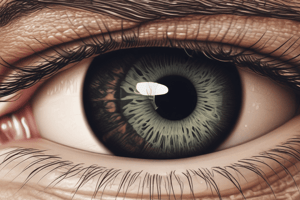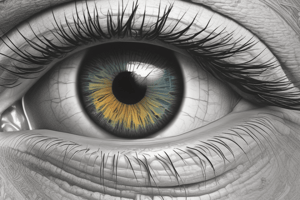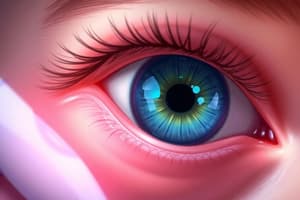Podcast
Questions and Answers
What is a common symptom of cataracts?
What is a common symptom of cataracts?
- Sudden loss of vision
- Glare when looking at lights (correct)
- Eye pain
- Double vision
What is a typical clinical finding on eye examination in a patient with cataracts?
What is a typical clinical finding on eye examination in a patient with cataracts?
- Abnormal pupil reaction
- Reduced red reflex (correct)
- Increased red reflex
- Constricted visual field
What is the definitive treatment of cataracts?
What is the definitive treatment of cataracts?
- Surgical management (correct)
- Laser therapy
- Refractive surgery
- Medication
What is a complication of unmanaged cataracts?
What is a complication of unmanaged cataracts?
What type of cataract can occur following both blunt and penetrating eye injuries?
What type of cataract can occur following both blunt and penetrating eye injuries?
What is the most common cause of blindness worldwide?
What is the most common cause of blindness worldwide?
What is the typical symptom of nuclear cataracts?
What is the typical symptom of nuclear cataracts?
What type of cataract is commonly associated with steroid use?
What type of cataract is commonly associated with steroid use?
What is the main reason for urgent referral to ophthalmology in congenital cataracts?
What is the main reason for urgent referral to ophthalmology in congenital cataracts?
What is a contributing factor to the development of cataracts?
What is a contributing factor to the development of cataracts?
Flashcards are hidden until you start studying
Study Notes
Cataracts
- A cataract is an opacification or clouding of the lens, the most common cause of blindness worldwide.
- There are three main types of cataracts, classified according to the part of the lens affected.
Types of Cataracts
- Nuclear cataracts:
- Caused by sclerosis of the lens nucleus.
- Common in old age.
- Symptoms include myopia (short-sightedness) and colors appearing dull.
- Patients may experience a decrease in need for reading glasses.
- Cortical cataracts:
- Caused by opacifications of the lens cortex.
- On ophthalmoscopy, the opacifications look like the spokes of a wheel around the edge of the lens.
- Vision is often unaffected.
- Posterior subcapsular cataracts:
- Caused by opacifications in the posterior aspect of the lens capsule.
- Typically affect younger patients and individuals taking steroids.
- Patients complain of glare when looking at lights (e.g., when driving at night).
- Progress more rapidly than other types of cataracts.
- Congenital cataracts:
- Present from birth.
- Associated with infection (e.g., congenital rubella syndrome) and genetic predisposition.
- Often diagnosed during the newborn examination due to the absence of the fundal reflex.
- Urgent referral to ophthalmology is required, as surgical management may be necessary in the first 6 weeks of life to prevent amblyopia.
Causes of Cataracts
- Age-related changes.
- Diabetes.
- Steroid use.
- UV exposure.
- Smoking.
- Ocular trauma.
- Genetic predisposition.
- Galactosemia.
- Wilson disease.
- Myotonic dystrophy.
Clinical Features
- History:
- Progressive blurring of vision.
- Glare when looking at lights.
- Colors appearing dull.
- Clinical examination:
- Reduced red reflex.
- Clouded lens.
- Mature cataracts with loss of red reflex.
Investigations
- Clinical diagnosis made following history and clinical examination.
- Slit-lamp examination with dilated pupils can support the diagnosis.
Management
- Conservative management:
- Control risk factors such as diabetes, smoking, steroid use, and UV exposure to slow down cataract development.
- NICE recommends refraining from surgical management until symptoms affect lifestyle.
- Surgical management:
- Phacoemulsification with an intraocular lens implant is the most common cataract surgery.
- Ocular biometry is conducted to measure the corneal curvature and shape of the eye before surgery.
- Complications of unmanaged cataracts include loss of vision.
Studying That Suits You
Use AI to generate personalized quizzes and flashcards to suit your learning preferences.




